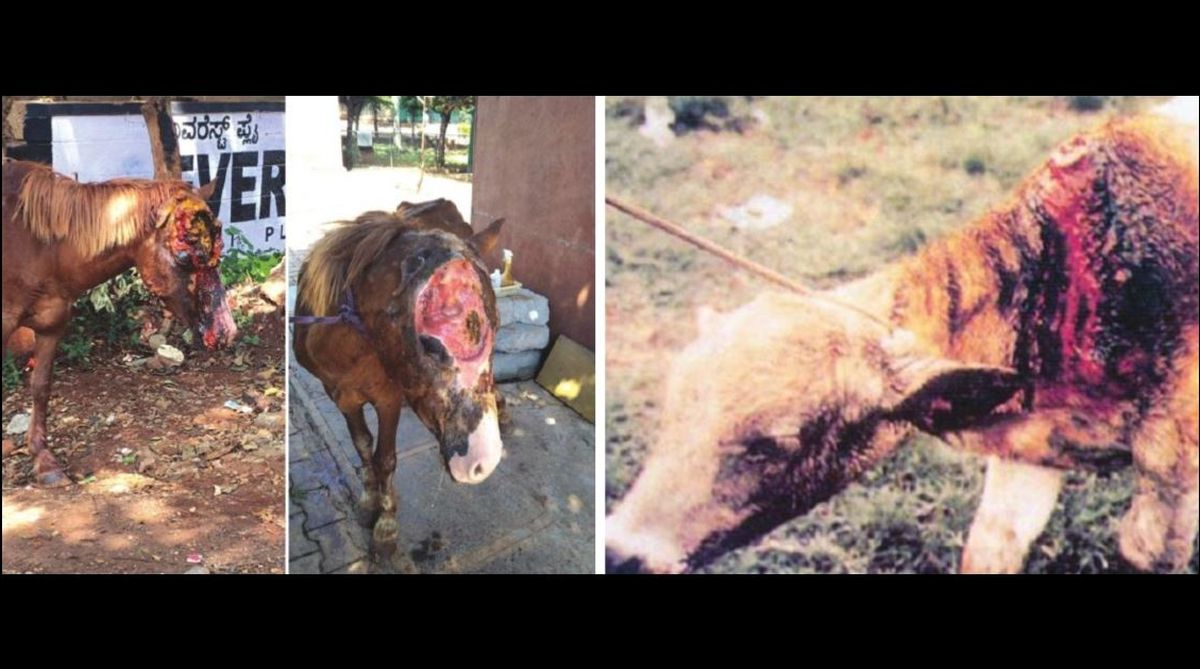People for Animals Mysore picked up a horse whose head had been half eaten. I am including his pictures – the before and after. This has been a success story, but there are a hundred others who have had to be put to sleep because the parasites had burrowed far too deep.
Animals put up with a great deal more pain than humans – but what is their option? There are no doctors to look after them. Most owners abandon them if they get sick. There are three killers on the road for stray and abandoned animals: distemper, parvo and maggots.
Advertisement
Have you ever come across a dog with gaping holes in its back? A cow with holes in its abdomen? A donkey with seeping wounds on its neck? These are maggot injuries. Every day we get dozens of cases at my shelter in Delhi, and it is heartbreaking that we allow our animals to reach such a stage.
Imagine if you had flesh-eating flies, and their larvae, landing on a slight wound on your skin and burrowing into your body till you have been eaten from the inside. And, when your body starts smelling because it is rotting away, people throw stones at you to shoo you away.
A horse brought to my shelter had a fist sized hole on its head, and his brain was exposed. Bali, as we later named him, was found lying in an abandoned building, at the brink of death. Flies had laid eggs on a wound near his ear and the maggots had eaten their way in. Bali had given up when he first arrived at the shelter, but how could we? This was a start to a 3-month recovery of Bali at my shelter in Delhi.
Myiasis, or infestation of the animal body with flies and their larvae or maggots, is one of the most common problems faced by animals, especially those on the streets. What attracts these flies to lay their eggs on the animal’s body, and what follows after?
These flies are attracted to any animal with an open wound left unattended – not just dogs, but cats, cows, horses, sheep, goats. The eggs are deposited and hatch within four hours when the weather is moist and warm. The young larvae start burrowing into the flesh of the animal. Animals who are weak and debilitated are ideal victims. Any type of draining wound, or a moist coat soaked in urine and faeces, can become the perfect spot for flies to lay their eggs.
Is it just street animals? No, a large number of pets come in. Their owners keep them chained outside in all weather, never brush their coats, feed them badly. They gnaw at themselves out of boredom, or the chain bites into their necks, and the maggots come in. It is only when they start smelling that the owners bring them in. Some want them treated. Others stand in line for treatment and then quietly slip out through the gate abandoning them forever.
How can you identify and treat a maggot-infested wound?
Maggot infested wounds are easily identifiable. Look for any unattended wounds on the animal’s body, a characteristic smell, and you will be able to see actual white maggots moving inside the wound/hole. Some of the more common places I have come across for maggots in a dog are the toenails and pads under the feet – which are less frequently checked – under the tail and on the head. If you see flies buzzing around any part of the animal make sure to find the wound and get it treated before those eggs hatch.
Treatment of maggot-infested wounds is fairly simple; however, complete recovery can take up to 1-3 months depending on how far the maggots burrowed. The vet starts off by putting some chloroform into the wound, waiting for a while and picking each maggot out one by one. Since we get hundreds of cases at my shelter, we use a mixture of chloroform and turpentine, in equal amounts, to kill the maggots.
In small animals, like dogs, the vet cleans the wound with an antiseptic before beginning to remove the maggots. He then applies Lorexene or Maggocide ointments, specifically meant to kill maggots. Once the wound is cleaned and the maggot-killing ointment applied, the vet then stuffs cotton gauze into the wound and covers it with a bandage.
It is very important to make sure the wound is airtight, this is, so the maggots left inside suffocate to death without any oxygen to breathe. Depending on the severity of the maggot infested wound, the vet makes the decision of changing the bandages twice, or once daily, while being extremely meticulous about removing all the maggots each time the bandage is opened.
As supportive therapy, Zincolak can help the wound heal faster. Antibiotics in the Sulphur range, or Amoxycillin which act as tissue healers, might also be prescribed by the vet. Once the healing begins, we usually use Betadine and Furacin ointment at the hospital for a rapid recovery.
Bali was one of the few lucky ones who survived. With constant care over a period of 3 months, Bali was back to being the beautiful horse that he was meant to be.
When animals are in pain, and are about ready to give up, they hide in dark places. Unfortunately, for the larvae these are perfect conditions to flourish and feed, speeding up the process of the animals evisceration and death. If you were to ever come across a wounded animal on the street, do make sure to call my shelter and save the animal from endless days of misery with maggots feeding on its flesh.
On one last note, maggot-infested wounds might be gross to look at, but are simple to treat, with basic medication and care. Make sure to keep an eye out for our animals on the streets.
To join the animal welfare movement contact gandhim@nic.in, www.peopleforanimalsindia.org











